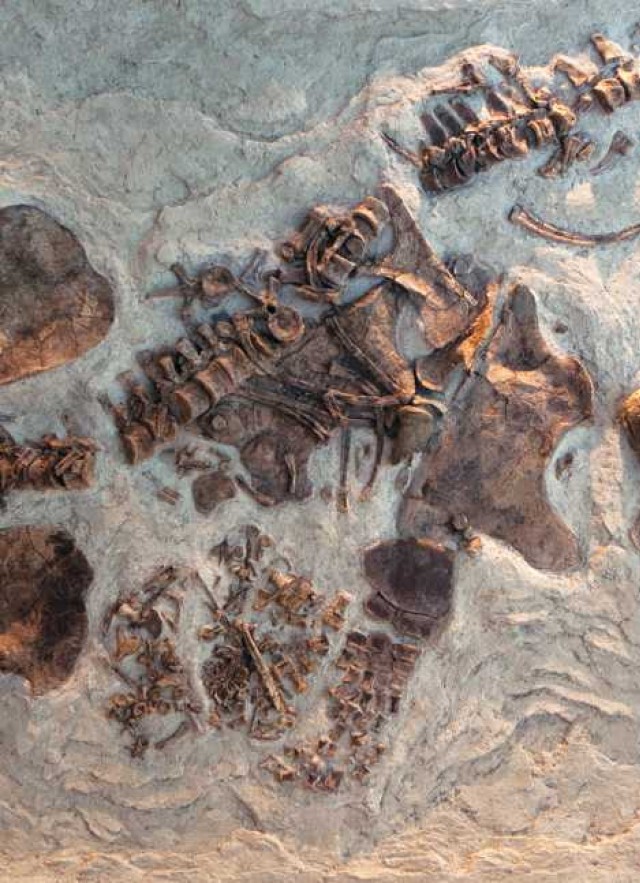Baby Plesiosaurs Were Weak Swimmers: New Analysis of Pregnant Plesiosaur Fossil on View at Natural History Museum of Los Angeles County
Hypothesis about extinct marine reptile reproduction is supported by latest research of fossil, which also adds further evidence for maternal care
Publication: 8am EST, Wednesday, January 2, 2019 https://academic.oup.com/iob/article-lookup/doi/10.1093/iob/oby007
January 2, 2019 — Los Angeles, CA — New research on plesiosaur fossils supports hypothesis that plesiosaurs gave birth to live young and provides new evidence of rapid fetal bone growth that resulted in babies that were poor swimmers and likely required parental care. Dr. Robin O’Keefe, research associate of the Natural History Museum of Los Angeles County (NHM) and professor at Marshall University; Martin Sander, professor at Bonn University in Germany; and Tanja Wintrich, Ph.D. candidate at Bonn University, co-authored the study in Integrative and Comparative Biology that analyzed the bone tissues of fossils of two species within the plesiosaur family: Polycotylus latippinus and Dolichorhynchops bonneri.
Plesiosaurs were a diverse family of giant marine reptiles (not dinosaurs) that lived during the Mesozoic Era and have no living relatives. They typically had broad bodies, short tails, and large flippers. They were among the top predators in the Western Interior Seaway, the large inland sea that existed during the Cretaceous period stretching from the Gulf of Mexico to the Arctic Ocean.
A previous study by O’Keefe and NHM Dinosaur Institute Director Luis Chiappe suggested that at least some plesiosaurs gave birth to live young about 40% the length of the mother — equivalent to a human mother giving birth to a six year old child. The research is based on a 78- million-year-old plesiosaur fossil on display in NHM’s Dinosaur Hall, known as the “Pregnant Plesiosaur”: an adult with the bones of a fetal plesiosaur in its abdomen. The specimen had resided in a Museum’s storage facility for decades before these researchers undertook their study and before this unique fossil was displayed.
The new study took bone samples from the mother and fetus to illustrate bone development in plesiosaurs, thereby shedding light on bone tissue samples from other fossils. Small core samples obtained with a specialized drill provided the opportunity to analyze the fine details of the bone structure with a polarizing microscope. It’s rare for a specimen on exhibit to be cited in new research, and rarer still for that analysis to utilize destructive sampling, where a small piece of the fossil is destroyed to aid in new research. Also of note was the particular challenge of taking fossil samples from a vertically-mounted specimen currently on display in a museum gallery: all standard sampling methods are based on drilling down into horizontal specimens.
“The Natural History Museum of Los Angeles County’s mother plesiosaur is a spectacular fossil, and it’s truly one of a kind. As scientists we like to have more data under our conclusions. This study gives us that, supporting the ideas that plesiosaurs had large babies and cared for their young,” said O’Keefe. “Our study also reaches the novel conclusion that plesiosaur fetal bone grew extremely quickly, sacrificing bone strength for growth rate. Plesiosaur babies may have needed maternal care for protection.”
Coauthor Martin Sander: "Plesiosaurs are the most remarkable marine reptiles of the era of the dinosaurs, and that extends to their apparent habit of carrying a single large life young."
Coauthor Tanja Wintrich: "This is the first time we drilled a vertically mounted skeleton on display in a museum!"
“This study is another example of how paleontologists around the world are looking at old fossils with new eyes,” said Luis Chiappe, Natural History Museum of Los Angeles County Dinosaur Institute Director, who curated NHM’s Dinosaur Hall were the pregnant plesiosaur is displayed.
The team also examined the histology and microanatomy of three other specimens: two partial skeletons from the University of Nebraska State Museum and one isolated front limb bone from the Field Museum of Natural History.
The results of this study support the hypothesis that plesiosaurs gave birth to large young that continued to grow quickly after birth. And the apparent tradeoff of this rapid growth was temporarily lower bone density in the young plesiosaurs, less suited to the challenges of navigating the water. The adult specimens showed higher bone density more consistent with the forces required for effective swimming. If young plesiosaurs’ bones were less suited for swimming and required time to build density, it could mean these marine reptiles required parental care when young. The team calls for further research among other species in the plesiosaur family to further document development and life history in these long-extinct marine reptiles.
About the Natural History Museums of Los Angeles County
The Natural History Museums of Los Angeles County (NHMLAC) include the Natural History Museum in Exposition Park (NHM), the La Brea Tar Pits, and the William S. Hart Museum. They operate under the collective vision to inspire wonder, discovery, and responsibility for our natural and cultural worlds. The museums hold one of the world’s most extensive and valuable collections of natural and cultural history—more than 35 million objects. Using these collections for groundbreaking scientific and historic research, the museum also incorporates them into on- and offsite nature and culture exploration in L.A. neighborhoods, and a slate of community science programs—creating a new natural history museum experience that explores the past, but increasingly addresses the present and the future.
